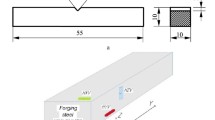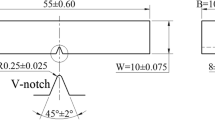Abstract
We demonstrate the possibility of using new physically substantiated characteristics of toughness of the metal and the embrittling action of a stress concentrator suggested earlier for the analysis of brittle fracture of standard Charpy specimens. We describe a procedure for the evaluation of the degree of embrittlement of a metal in impact tests. It is shown that the threshold values of the specific work of fracture KCV used to reject the metal must be corrected depending on the level of strength of steel. For low-, medium-, and high-strength steels, we propose physically substantiated threshold values of KCV.
Similar content being viewed by others
REFERENCES
S. A. Kotrechko, Yu. Ya. Meshkov, G. S. Mettus, and D. I. Nikonenko, “Mechanics and physics of quasibrittle fracture of polycrystalline metals under conditions of stress concentration. Part 3. Toughness of metals and alloys,” Probl. Prochn., No. 1, 72–92 (2000).
G. T. Hahn, “Influence of microstructure on brittle fracture toughness” Met. Trans., 12A, 947–957 (1984).
Yu. Ya. Meshkov, Physical Grounds of Fracture of Steel Structures [in Russian], Naukova Dumka, Kiev (1981).
W. Dahl and P. Belche, “Strain diagram” in: W. Dahland and W. Anton (Eds.), Werkstoffkunde Eisen und Stahl. Teil 1: Grundlagen der Festigkeit, der Zähigkeit und des Bruchs [Russian translation], Metallurgiya, Moscow (1986), pp. 51–133.
I. K. Pokhodnya, V. I. Shvachko, A. V. Shiyan, et al., “On the nature of brittle fracture of structural steels and their welded joints subjected to tests by impact bending” Avtomat. Svarka, No. 5, 1–4 (1988).
S. A. Kotrechko, Yu. Ya. Meshkov, and G. S. Mettus, “On the physical nature of strength of bcc metals within the temperature range of the ductile-brittle transition” Metallofiz. Noveish. Tekhnol., 16, No. 11, 31–34 (1994).
S. A. Kotrechko, Yu. Ya. Meshkov, and G. S. Mettus, “Mechanics and physics of quasibrittle fracture of polycrystalline metals under conditions of stress concentration. Part 1. Experimental regularities,” Probl. Prochn., No. 4, 5–16 (1997).
L. A. Kopel'man, “Comparison of the results of testing of low-carbon steel by impact bending and uniaxial tension,” Avtomat. Svarka, No. 12, 7–11 (1975).
A. R. Resenfield and G. T. Hahn, Numerical descriptions of the ambient low-temperature and high-strain rate flow and fracture behavior of plain carbon steel, Trans. ASME, 59, 962–980 (1966).
S. A. Kotrechko, Yu. Ya. Meshkov, D. I. Nikonenko, et al., “Impact strength of shipbuilding steels and estimation of their susceptibility to brittle fracture,” Metalloved. Term. Obrab. Met., No. 3, 27–30 (1997).
Yu. Ya. Meshkov and T. N. Serditova, Fracture of Deformed Steel [in Russian], Naukova Dumka, Kiev (1989).
Author information
Authors and Affiliations
Rights and permissions
About this article
Cite this article
Kotrechko, S.A., Meshkov, Y.Y. Physical Interpretation of Fracture Characteristics Determined in Testing Charpy Specimens by Impact Bending. Strength of Materials 33, 356–361 (2001). https://doi.org/10.1023/A:1012460627839
Issue Date:
DOI: https://doi.org/10.1023/A:1012460627839




